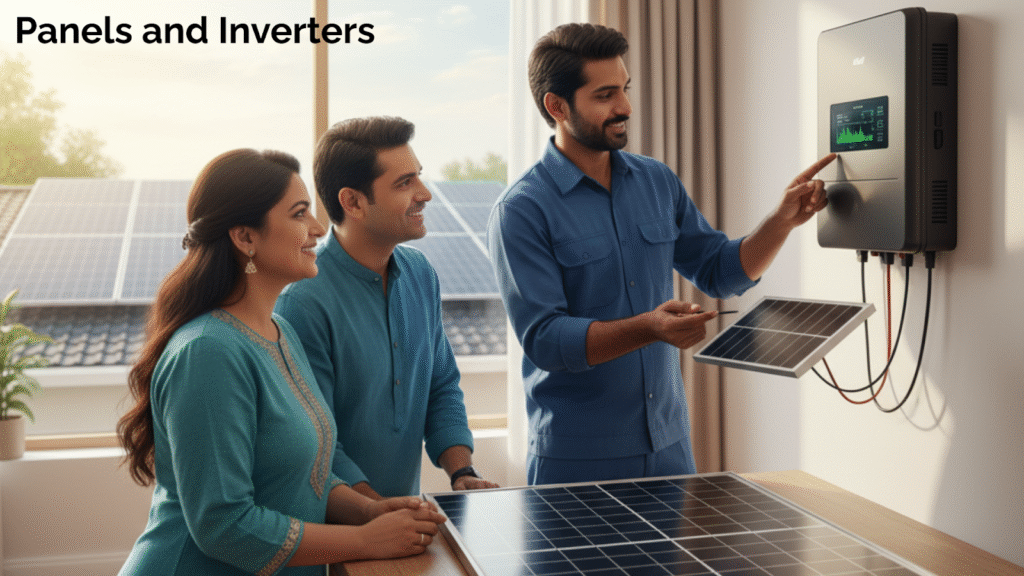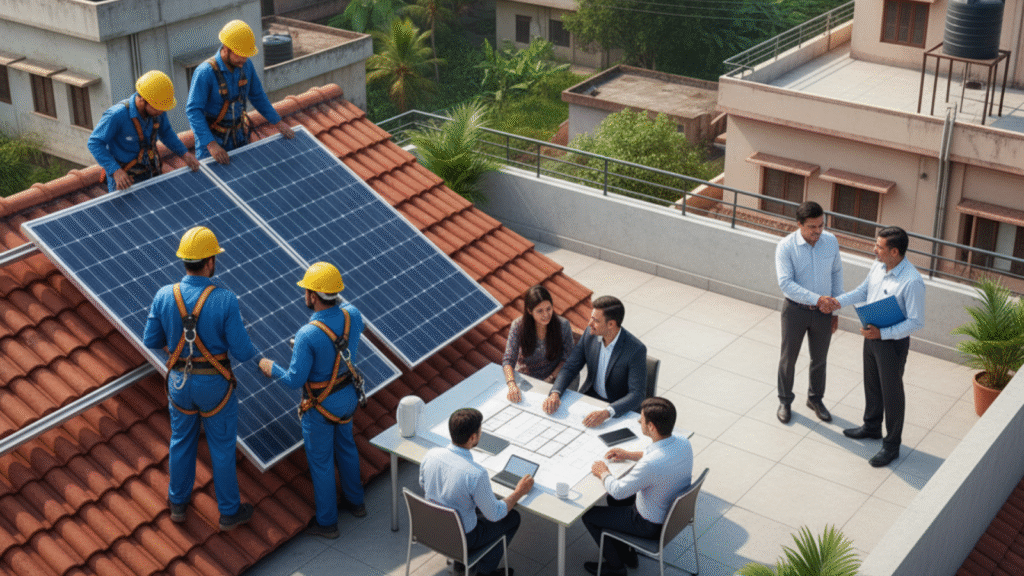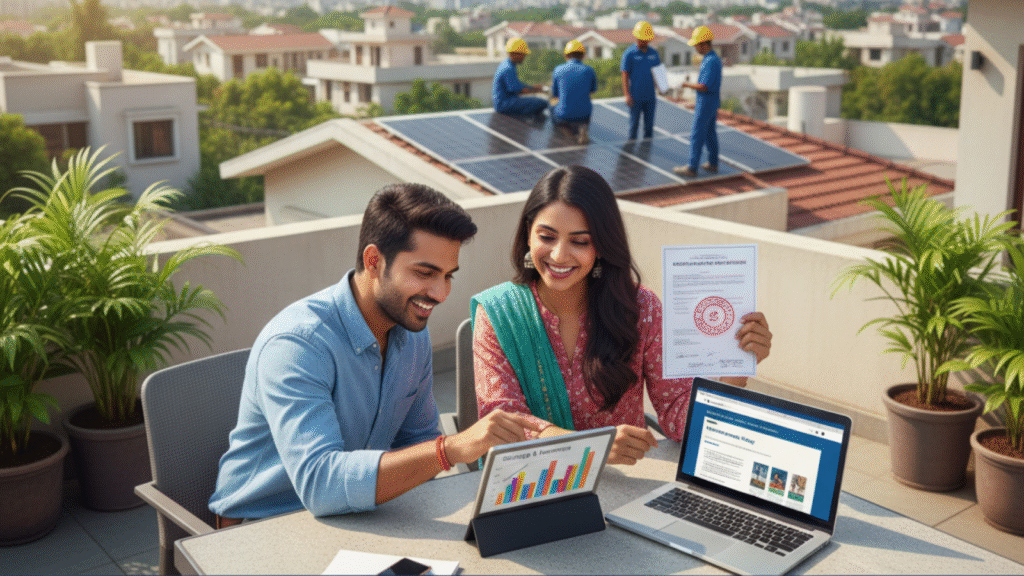
Planning to switch to solar? The total solar panel installation cost is much more than just the price of the panels. It’s an investment in high-quality hardware, specialized labor, and a self-reliant future that guarantees energy security. This guide is your complete, transparent roadmap to every expense involved in setting up your residential solar system. We will explore how different equipment choices impact the final budget. Let’s break down the true cost.
Understanding the True Solar Panel Installation Cost

Switching to solar power is one of the smartest long-term investments a homeowner can make. However, the initial figure for the solar panel installation cost often seems complicated. We will first look at the most significant part of the budget: the core equipment, including the high-efficiency panels and modern inverters. Understanding the cost per watt is crucial for comparing quotes effectively and ensuring you get the best value for your hard-earned money.
1. Core Equipment: Panels and Inverters

The solar panels and inverters form the heart and brain of your system. Their type and quality determine your system’s efficiency, lifespan, and overall value. Therefore, the decisions you make here significantly influence the final solar panel installation cost and your long-term savings.
Solar Panels: The Biggest Cost Driver
The panel’s cost is determined by its type and efficiency. You must choose wisely to optimize your rooftop space.
| Panel Type | Efficiency (Approx.) | Cost Factor | Best For… |
| Monocrystalline | 17% – 22% | Higher cost | Limited Space; maximize power output. |
| Polycrystalline | 15% – 17% | Lower cost | Large Roofs; the most budget-friendly option. |
Inverters: Converting Power, Controlling Your Budget
The inverter is the brain; it converts DC power from panels into usable AC power for your home.
- String Inverters: These are common and affordable. They connect a “string” of panels to one central unit.
- Microinverters: These cost more, but they are installed under each panel. Therefore, they are excellent for roofs with shading because they ensure higher overall efficiency.
Key Takeaway: High-efficiency panels and microinverters will raise your initial solar panel installation cost. However, they guarantee greater energy production and better long-term performance.
2. Breaking Down the Soft Costs: Labor, Components, and Permits

The final price is not just hardware. “Soft costs” cover essential non-hardware expenses, including the installation work, supporting components, and critical administrative fees. Understanding these elements is vital to accurately estimate your solar panel installation cost.
| Component Category | Description of Cost Included | Approximate Share of Total Cost |
| Installation & Labor | Physical mounting, electrical wiring, system testing, and project management by experts. | 15% – 25% |
| Balance of System (BOS) | Racking, mounting structures, essential wiring, and safety disconnects. | 10% – 15% |
| Permitting & Fees | Local permits, inspection fees, design work, and utility interconnection costs. | 5% – 10% |
| Sales & Overhead | The installer’s business operations, marketing, and profit margins. | 15% – 20% |
Note: Complex roof structures (steep pitch or older tiles) will push the Installation & Labor cost toward the higher end.
3. Strategies to Lower Your Final Solar Panel Installation Cost

While the upfront cost is necessary, you don’t have to bear the full burden. You can significantly offset the initial investment using various financial incentives and smart policies. Here are the top ways to reduce your solar panel installation cost and maximize your ROI.
- Government Incentives: Check for central and state-level subsidies and tax credits. These programs can reduce your upfront financial burden dramatically.
- Net Metering: This brilliant policy allows you to sell excess electricity back to the grid. You earn credits that lower your monthly utility bills and drastically improve your Return on Investment (ROI).
- Financing Options: Explore specialized solar loans. Often, your monthly loan payment is less than your previous electricity bill, giving you immediate financial benefits.
Frequently Asked Questions (FAQ) About Solar Installation Cost
Q1. What is the average solar panel installation cost?
A. The national average solar panel installation cost for a typical residential system varies by size and location. For example, a standard 3kW system might range from ₹1,50,000 to ₹2,20,000 before subsidies. We always calculate costs on a ‘per watt’ basis for better comparison.
Q2. Does adding a battery increase the installation cost?
A. Yes, it does. Adding a battery for energy storage significantly increases the total solar panel installation cost. Batteries are essential for energy backup during power cuts but are optional for most grid-tied homes.
Q3. How long is the payback period for solar?
A. The payback period—the time for savings to equal your initial cost—is typically 4 to 8 years in India. After this, your electricity generation is essentially free for the system’s 25+ year lifespan.
Q4. Why are labor and soft costs so high?
A. Labor involves skilled electricians and certified installers. Soft costs cover mandatory steps like site assessment, engineering, permits, and utility connection. These non-hardware parts are vital for a safe, high-performing system.
Q5. Is buying better than leasing solar panels?
A. Buying (or financing) offers a higher long-term financial benefit. You get full ownership, better tax benefits, and a higher increase in home value. Leasing avoids the upfront solar panel installation cost but provides fewer long-term savings.
Conclusion: Making a Smart Investment in Your Home’s Future
The initial figure for the solar panel installation cost might seem large, but a detailed breakdown shows you are investing in quality hardware, essential safety, and expert labor. Furthermore, you are securing your home against unpredictable fossil fuel price hikes. Fortunately, Government subsidies, net metering, and lower component prices have reduced the financial barrier, making solar accessible to a wider demographic than ever before.Focus on the long-term ROI. A solar system is a financial asset that protects you from rising electricity costs, offers a solid payback period, and increases your property’s value significantly. By understanding the breakdown of costs, you empower yourself to choose the right installer and confidently move towards lasting energy independence.

